
Ornitholestes is a genus of small theropod Dinosaur that lived during the Late Jurassic period, approximately 150 million years ago. Its name translates to bird robber or bird predator, indicating its carnivorous nature. This dinosaur belongs to the family Coeluridae, and it is notable for its role in understanding the ecology and diversity of theropod dinosaurs during the Jurassic era.
Ornitholestes was first described by American paleontologist Othniel Charles Marsh in 1887 based on partial remains found in the Morrison Formation of Wyoming, USA. Subsequent discoveries have expanded our knowledge of this dinosaur, although the available fossil material is still relatively limited.
| Name: | Ornitholestes dinosaurs |
| Size: | Length: around 6 to 9 feet ; Weight: approximately 30 to 75 pounds. |
| Main Facts: | Ornitholestes is a small theropod dinosaur from the Late Jurassic known for its carnivorous diet and agile hunting abilities. |
Ornitholestes was a small-sized dinosaur, with an estimated length of around 6 to 9 feet (1.8 to 2.7 meters) and weighing around 30 to 75 pounds (14 to 34 kilograms). As a theropod, it walked on two legs and had long, slender hind limbs, allowing it to be a swift and agile predator. Its forelimbs were smaller in comparison, with three-fingered hands.

During the Late Jurassic, North America was a diverse ecosystem inhabited by various dinosaurs, including sauropods, stegosaurs, and other theropods like Allosaurus. Ornitholestes shared its environment with these larger predators and may have occupied a niche as a smaller, agile hunter targeting different prey items. The Morrison Formation's fauna represents a complex and dynamic ecosystem that contributed to our understanding of dinosaur interactions and coexistence during that time
As a small theropod, Ornitholestes was not at the top of the Late Jurassic food chain. It likely had to contend with competition from other small predators, evade larger carnivores like Allosaurus, and avoid becoming prey for even larger dinosaurs. Understanding the predator-prey relationships in these ancient ecosystems provides valuable insights into the ecological dynamics and interactions among different dinosaur species.
Ornitholestes,along with many other dinosaurs, eventually faced extinction at the end of the Jurassic period. The causes of this mass extinction event remain a subject of scientific debate, but factors such as changes in climate, sea-level fluctuations, and volcanic activity likely played roles in shaping the late Jurassic extinction event.
Ornitholestes was a small dinosaur, estimated to be around 6 to 9 feet in length and weighing approximately 30 to 75 pounds. This puts it in the category of smaller theropods.
Like many theropods, Ornitholestes was a carnivore, preying on small animals such as insects, lizards, and small mammals. This diet is common among theropods, which were primarily meat-eating dinosaurs.
As a theropod, Ornitholestes walked on two legs and had long, agile hind limbs. This bipedal locomotion was a characteristic shared by many theropods.
Ornitholestes lived during the Late Jurassic period, around 150 million years ago. This places it in the same time frame as other well-known dinosaurs such as Allosaurus and Stegosaurus.
Ornitholestes inhabited the floodplain environments of the Late Jurassic, which were characterized by lush vegetation and diverse wildlife. It likely shared its habitat with other dinosaurs, contributing to complex ecological interactions.
Ornitholestes occupied a niche as a small predator in the Late Jurassic ecosystem, likely avoiding competition with larger theropods like Allosaurus. Understanding its role in the ecosystem helps us comprehend the diversity and interactions of dinosaurs during that time.